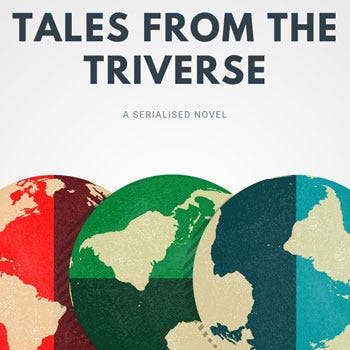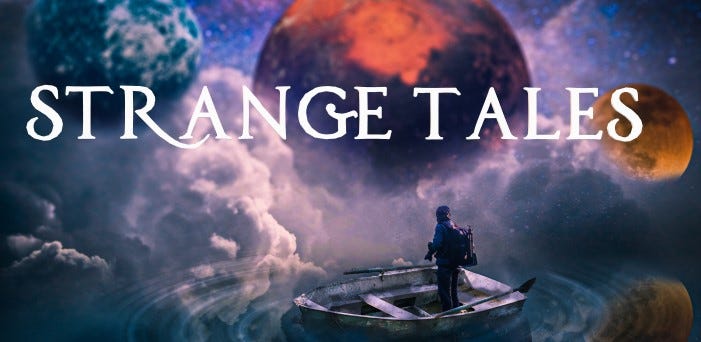How serial writing works for plotters & pantsers
Foreshadowing and just-in-time planning
If you’re intending to write your entire book up-front before serialising it, then this chapter probably doesn’t apply. If you’re planning on doing a ‘live write’, whereby you’re writing and publishing simultaneously…then read on.
A quick note to say that Tales from the Triverse, my current weekly serial, is now on chapter 12. Yes, that means I’ve been writing and publishing this thing for 12 weeks. Maths. If you’re curious you can jump into the story from the start:
It’s an extremely fun mash-up of crime fiction (it’s got detectives and everything), sci-fi and fantasy. I’m really enjoying writing it, so you might like reading it!
A writer of serialised fiction has to figure out where they belong on the universal scale of Plotters vs Pantsers, with plotters figuring out every last detail prior to writing and pantsers making it up as they go. When writing a book ‘offline’, whereby you complete the entire manuscript before anybody else sees it, it ultimately doesn’t matter how you write the book, as long as you write it. However, if you’re putting a new chapter up each week, even if you have a healthy buffer built-in, the situation is very different: people are already reading your work and you don’t want to get halfway only to run yourself into a narrative dead-end or drop into a perilous plot hole.
Assuming that you’re intending to be fair to your readers and not go back to sneakily mass-edit previously published chapters - which would rapidly alienate potential fans - you’re going to have to either be supremely confident in your pantser skills, or you’re going to need to become at least a partial plotter.
It’s still up to you how much planning to do, but you want to have enough of an idea of what’s coming up that you won’t run aground or feel the need to do a substantial structural retro-edit at some point down the line.
there’s no opportunity to go back and fix things if you realise you’ve made a mistake
How to best summarise this? Think of your favourite TV show, ideally one that is telling a long-running story over several seasons. The creators of that TV show probably did not write every single episode of the entire series prior to the first episode being broadcast, and they certainly had not produced every episode. It will vary depending on lead times, but season one of a show will probably have aired before they get to work on season two. In other words, there’s no opportunity to go back and fix things if you realise you’ve made a mistake.
At that point you have a choice: you either perform a retcon (retroactive continuity), whereby you explain away some incongruity with a wave of your authorial hand, or you ignore it completely. Older shows from the 20th century did the latter a lot, including mad stuff like introducing siblings of major characters who had never been mentioned before (Buffy the Vampire Slayer parodied this brilliantly). Both Star Trek and Star Wars frequently use retcons to patch over shonky storytelling, often relying on their extended universes to fix issues in the core texts (“not sure how Emperor Palpatine built a massive fleet of ships without anyone noticing in Rise of Skywalker? Don’t worry - we have a comic for that!”). Done well, retcons can be fun and effective; done poorly and they begin to undermine the story’s fictional universe, as if the wooden set is about to collapse at any moment.
Writing a novel in a traditional way gives you every opportunity to avoid or fix these issues, because you’ll have the entire thing in your hands before releasing it into the world. It’ll go through multiple drafts and edits and numerous pre-release readers, with the version seen by readers being highly finessed. Serialisation likely won’t afford you that luxury, so requires a slightly different mindset.
If you’re a plotter, it might benefit you to be a little more agile in your mindset so that you can roll with new ideas that emerge during the writing and publishing of the story.
If you’re a pantser, I’d highly recommend introducing some plotting into your workflow so as to avoid problems and enable you to incorporate some additional storytelling magic which would otherwise be tricky (more on this in a moment).

Just-in-time plotting
I break my stories down into distinct chunks for serialisation, with varying levels of detail. I’ll have an end point in mind for any story, so it’s then about how to get from A to B in a compelling way.
Step one is to separate the main story into separate plot arcs, like the ‘parts’ of a novel. I think of these much like a season of a television show. Each of these arcs then gets its own mini-storyline and end goal, so that I know where I need to be by the end of that arc. The arc can have its own themes, supporting characters and sub-plots, distinct from the primary storyline but still working in support of it. The plot for an arc can be a single sentence, so it doesn’t need to be a massively complex, 500 word synopsis. And, in fact, probably shouldn’t be if you’re to avoid stressing yourself out.
Step 2: Usually the arc I’m working on will have more detail than later ones. When I start writing, Arc 1 will be much more defined than Arc 4. I’ll break the current arc down from that single sentence into a more detailed plot, and usually down into chapters. I tend to stick to a defined number of chapters per arc, which varies depending on the book, which then helps me to pace the arc. If I’m doing ten-chapter arcs, I know I have ten individual chapters to get the plot from A to B. Because I’m serialising the story, ten chapters = ten weeks. Does the story sustain itself sufficiently over those ten weeks, such that it’ll keep readers interested?
Step 3: Those individual chapters will, again, usually only be described in a single sentence, until I get to them. I’ll work out more of the specific details the closer I get to writing them. I keep the detail low in advance because it enables me to stay agile and keep ideas flowing in a flexible way. Most of my best ideas occur during the writing process, so it’s crucial that I leave space in the process for those ideas to emerge and be woven into the project; if I was too prescriptive and went too deep into the plotter mentality, I’d risk feeling chained to my own outline. That’s when characters start behaving oddly, in order to fit into the pre-ordained plot, and it ain’t pretty. Once I get to writing a chapter, I’ll usually rough out the sequence of events, a bit like working out staging for a play. This is about feeling the beats of the chapter, and helps clarify where I need to be by its end.
In other words, it’s a rolling, evolving style of plotting that scales its level of detail relevant to what I’m writing at any given time.
It doesn’t always work quite that neatly: often what I expect to be a single chapter will grow into two chapters. This can happen if I spend more time on character development than I’d anticipated. The choice is whether to make an extra-long chapter, or to split it across another week.
A major benefit of this just-in-time approach is that I always know what’s coming up. I never sit down to write the week’s chapter and find myself unsure of what’s happening. I might not know the specifics yet, and I might still change my mind if I come up with something better, but I always know what to think about next. It removes the strain and stress of uncertainty and avoids being ambushed by ‘writers’ block’, which is not something you want to experience when writing a live serial.
How to do foreshadowing
The other reason you might want to do some up-front plotting is that it is the only way to reliably implement foreshadowing when you’re serialising an in-progress novel.1
Think of the principle of Chekhov’s gun. The theory is that you should not introduce irrelevant details to a novel, and that you shouldn’t produce a magical solution without having established its existence earlier. If a character uses a gun in the final act, you should show the weapon in the first act. It’s very easy to break the principle of Chekhov’s gun as a publish-as-you-go author.

If you’re writing more traditionally, or if you’re completing your entire manuscript up-front before serialising, it’s not an issue - you can go back and work in as much foreshadowing as you want, and pull together all the themes and references that make the whole project sing.
If you’re serialising as you go, you don’t get that chance. But readers get a lot out of a book that holds together coherently, in which the start ties to the end and vice versa. Especially if they’re reading a serial over an extended period of time, it’s immensely satisfying to have something mentioned in chapter 2 pay off in chapter 42. Unless you rely on a lot of lucky retcons, you’re going to want to plan stuff out in advance, to enable this to happen. It’s the only way to make your story resonate.
This doesn’t mean going into massive detail or becoming 100% a plotter. What you can do is identify early what your big story moments are going to be, especially in the second half of the story. How are the characters going to change? What’s going to motivate that change? Is there a big twist? Do characters end up behaving in unexpected ways which risk annoying the reader if you don’t seed the idea effectively (hi, Daenerys!).
there’s a reason there’s a random snake in the plane at the start of Raiders of the Lost Ark
Know that a character is going to betray another halfway through the book? Put some dialogue in that hints at it, right back at the start. Is there a big mystery to unravel? Make sure some clues are hidden in plain sight! Is a character going to face a major challenge late in the story? Make sure you build in some fears or anxieties relevant to that challenge in their introduction (there’s a reason there’s a random snake in the plane at the start of Raiders of the Lost Ark).
I’ve had some readers re-read The Mechanical Crown, my big fantasy novel which I published weekly over the course of three years. Based on their comments it sounds like the thing holds together on a second read, which is largely thanks to employing these techniques during the live-write.
Is post-publish editing ever OK?
Well, sure. It’s your story, your book, do what you want with it.
However, do think about how it’ll affect your audience. Imagine you’re watching a show on Netflix, and halfway through season three a character refers to an episode from season one in a way that doesn’t match your memory of the episode. So you go back and check, and it turns out Netflix sneakily uploaded a new version of the episode with a completely different final scene. Not problem for newer viewers who came along later, but annoying for you and anybody who was there from the start.
If you spot a typo, or a flat-out, straight-up mistake, then 100% go and fix it. During the initial serial run of A Day of Faces I made a stupid error whereby a character who had earlier in the story lost an arm proceeded to clap in a later chapter. As in, with both hands. It was a stupid oversight (and quite insensitive on my part, obviously), rapidly pointed out by a reader, and I immediately went in and updated it. It didn’t change any plot details, it just fixed a silly mistake.
I have to live with those decisions and find creative solutions
I tend to draw the line at plot changes: if an edit will fundamentally change what happens in the story, then I won’t do it. I have to live with those decisions and find creative solutions. If I’m fixing small errors, or improving wording in a sentence, then that’s fine, as it doesn’t invalidate what has already been seen by early readers.
Due to the pace of serialised storytelling I rarely have time to go back and tinker with earlier chapters. That kind of major edit comes later, once the initial run of the story is complete, and it’s something I’ll cover in a future chapter of this guide. During the serialisation itself, you need to stay focused on what you’re writing, and what’s coming up. That’s why having a plan helps immeasurably, and takes out a lot of the potential stress points.
Unless you’re writing a story about time travel, of course, in which you could build live editing into the story itself, with the previous chapters of the story shifting based on what the time travelling character is doing in the later chapters. As in, the character is literally time travelling back through earlier chapters and changing what happened. One day I might write that.
Thanks for reading! I hope that was useful. This is how I love to write and it’s definitely not for everyone. My experience is that it got me out of procrastinating and helped me to write and complete three novels, so I have only good things to say about it.
MEANWHILE. Looking for a fresh Christmas read? You should check out Strange Tales, a book promo I’m taking part in which is packed full of stuff you won’t have encountered before. Take a browse here.
I’ll see early access subscribers on Friday for the next chapter of the ‘Backdoors’ storyline. You can preview that one here, if you’re so inclined:
Thanks for reading!
Simon K Jones
You may have noticed that I foreshadowed this section of the newsletter earlier.






I am writing and publishing a serial "on the fly" and it is certainly a different challenge than writing a novel in private.
But I don't believe anyone is a complete "plotter" or "pantser." Having a story idea is plotting in your head and writing fiction is "pantsing." I think how much of each we do depends on what we are writing and the length. And personal preference.
On a related note:
The new Counter Craft newsletter [ https://countercraft.substack.com/p/plotter-pantser-scribbler-scribe ] was about the terms pantser and plotters, and it appears that Lincoln and I agree that there are too many ridiculous terms like Pantser and Dribble in writing. 🤣
I love that web like picture for this post! For a final on Dickens' A Tale of Two Cities, we were given a large sheet of paper, rulers, and a pencil. All of the characters were listed along the side and we had to draw lines connecting them to other characters with their relationship described. It was such a good exercise and such a good way to get into the author's mind, too. When I think about plotting, that's often what I think about: a web of character connections.